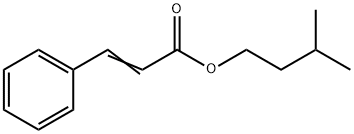Description
Isoamyl cinnamate has a balsamic odor reminiscent of cocoa. May
be prepared by esterification of cinnamic acid with commercial
isoamyl alcohols, which vary in isomer distribution according to
source.
Chemical Properties
pale yellow liquid with an iridescent sheen
Chemical Properties
Isoamyl cinnamate is a colorless, somewhat viscous liquid. Insoluble
in water, soluble in alcohol and oils, poorly
soluble in Propylene glycol. B.P. 310℃.
Sp.Gr. 1.00. Isoamyl cinnamate has a balsamic odor reminiscent of cocoa.
Occurrence
Reported found in cinnamon and port wine
Uses
Isoamyl cinnamate is Used in perfumes for Oriental notes, Chypre, Ambre, and as a fixative-blender in spicy
fragrance types (Carnation etc.). Quite stable
in soap and a fair fixative. However, it tends
to polymerize in storage. An increasing cloudiness, accompanied by increased viscosity and
decreased odor level are signs of beginning
polymerization. It is used in flavors for imitation Butter, Caramel, Fruit, Honey, Peach, Pineapple, Strawberry, etc. and in traces in Vanilla compositions to introduce warm-balsamic notes
resembling Cocoa or Chocolate. Concentrations in finished foods: up to
12 ppm in candy or baked goods.
Definition
ChEBI: Isoamyl cinnamate is a cinnamate ester.
Preparation
By esterification of cinnamic acid with commercial isoamyl alcohols, which vary in isomer distribution according to
source.
Taste threshold values
Taste characteristics at 35 ppm: sweet, floral, powdery, berry, and spice nuances
General Description
Pale yellow liquid with iridescent sheen.
Air & Water Reactions
Insoluble in water.
Reactivity Profile
An ester. Esters react with acids to liberate heat along with alcohols and acids. Strong oxidizing acids may cause a vigorous reaction that is sufficiently exothermic to ignite the reaction products. Heat is also generated by the interaction of esters with caustic solutions. Flammable hydrogen is generated by mixing esters with alkali metals and hydrides.
Fire Hazard
Isoamyl cinnamate is probably combustible.
